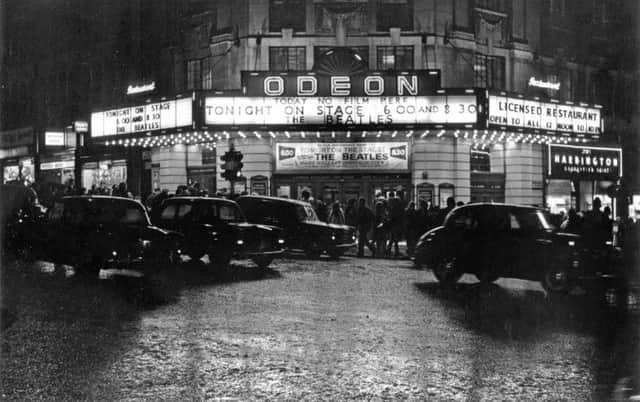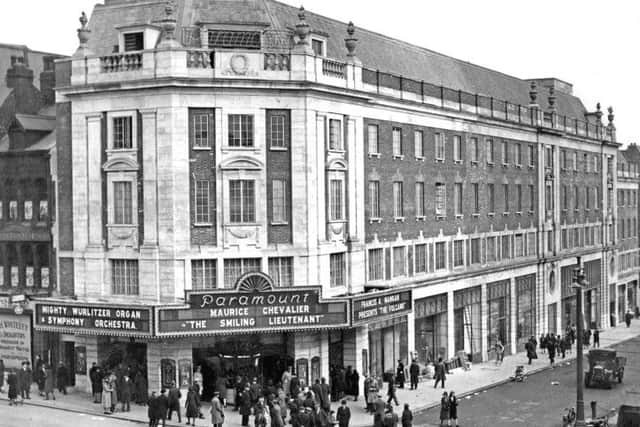Big-screen adventures at the Paramount


Such a building was the Leeds Paramount Theatre, which rose magnificent and modern at the corner of The Headrow and Briggate, adhering to The Headrow’s new building line. The theatre, loosely meaning at this time a building used for mainly cinema but including some theatrical performances, was designed by architectural firm Verity & Beverley. The exterior design was by Sir Reginald Blomfield, who also produced plans for The Headrow widening scheme.
The Paramount was built for and operated by the American-based Paramount Pictures. Other magnificent Paramount cinemas could be found in Birmingham, Manchester Liverpool, Newcastle-upon-Tyne, Glasgow and London’s Tottenham Court Road.
Advertisement
Hide AdAdvertisement
Hide AdOpening on February 22, 1932, the Leeds building was one of Paramount’s “shop window” theatres, aiming to present first-class entertainment in first-class surroundings.


The first general impression at Leeds Paramount was one of splendour. Contemporary accounts mention that from Briggate the patron stepped into the spacious entrance hall and foyer, and caught the first glimpse of the unusual green and gold, blue and silver decoration, which was carried in a striking theme throughout the theatre. There, the visitor’s feet sank into the deep carpeting, heavily piled and felted, so that the movements of patrons would not disturb those who were already seated.
The auditorium was designed purely and simply for comfort and good hearing. It could seat 2,500 people – 1,550 in the stalls and 1,000 in the balcony. Every seat was planned so that each one had an undistorted view of the screen and stage.
The first film shown at the Paramount was The Smiling Lieutenant with Maurice Chevalier and Claudette Colbert. In accordance with the “shop window” policy, it was intended that the Paramount would screen exclusively the first presentation of Paramount pictures in the Leeds area, as well as other productions of merit.
Advertisement
Hide AdAdvertisement
Hide AdAdditionally, the Paramount devoted a good part of the cinema programme to stage shows. It was intended that Tiller troupes of dancers would come direct from London. There would be musical and scenic novelties; Rex O’Grady at the Wurlitzer organ; and music by the Paramount Symphony Orchestra.
But, within five years, the Paramount was under threat from the Odeon empire. The name Odeon had been associated with British cinemas since 1930. The founder of the UK Odeon cinemas chain was Oscar Deutsch, born in Birmingham, the son of a Hungarian Jewish scrap metal merchant. The first Odeon cinema opened in Perry Barr, Birmingham in 1934. By 1937 Deutsch had 250 Odeons. This made Odeon one of the three major circuits in the UK, the two others being Associated British Cinemas (ABC) and Gaumont-British Cinemas .
During 1937, Odeon had plans ready to build a colossal cinema for Leeds on a site which faced Woodhouse Lane. They also planned other more modern cinemas where Paramount theatres were already in existence. This prompted talks between the British head of Paramount and Deutsch over the lease or sale of Paramount’s provincial cinemas to Odeon.
On November 23, 1939, Deutsch reached an agreement to take over seven of Paramount’s cinemas on 35-year leases. Paramount retained its London venues, the Plaza and Carlton.
Advertisement
Hide AdAdvertisement
Hide AdOn April 15, 1940, the Leeds Paramount was renamed Odeon. High spots under the Odeon banner in Leeds included several performances by The Beatles and an appearance by Judy Garland in a two-hour-long marathon on October 16, 1960. The show began with her tripping on to the stage wearing a pair of borrowed shoes. Somewhere, in the rush of the journey from London, her own footwear had been misplaced.
In the following decades the Odeon underwent alterations to accommodate screen divisions to try to beat off competition. Sadly, on October 28, 2001, after nearly 70 years, the cinema closed its doors for the last time.